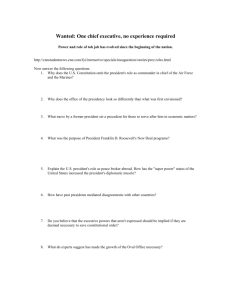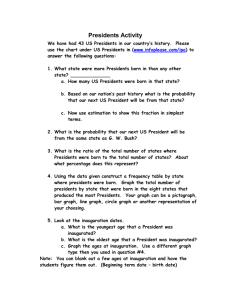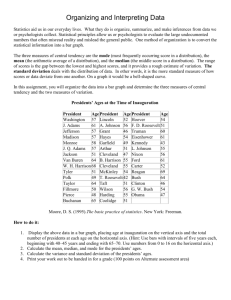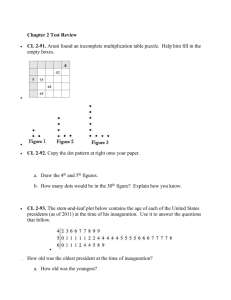word document - Kansas State University
advertisement
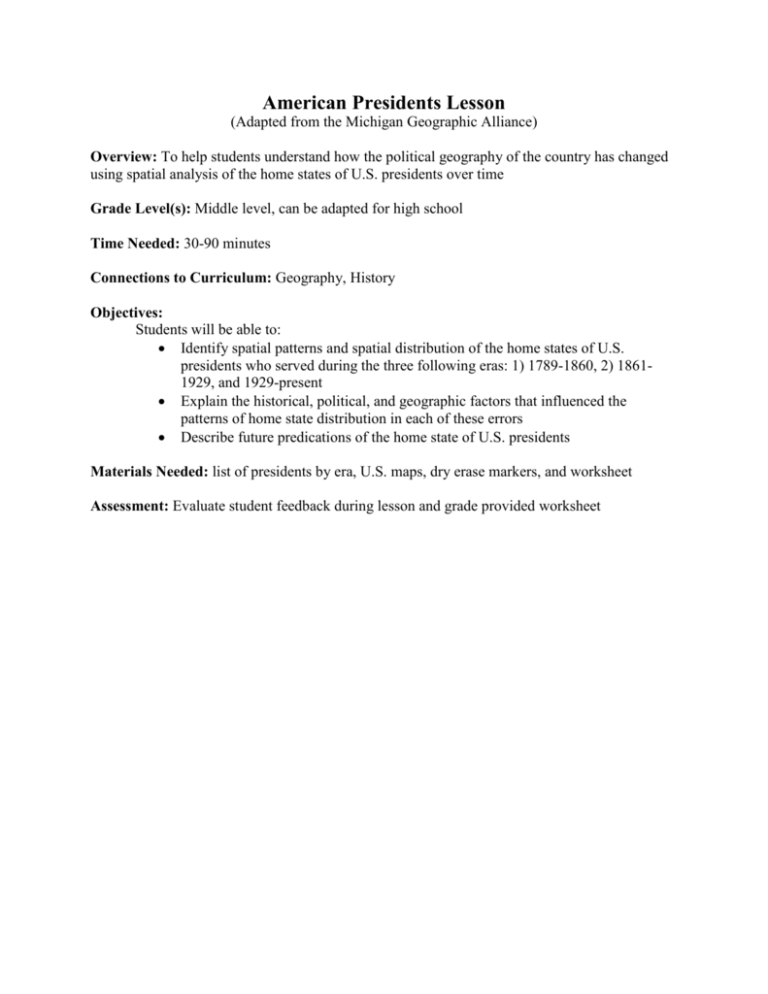
American Presidents Lesson (Adapted from the Michigan Geographic Alliance) Overview: To help students understand how the political geography of the country has changed using spatial analysis of the home states of U.S. presidents over time Grade Level(s): Middle level, can be adapted for high school Time Needed: 30-90 minutes Connections to Curriculum: Geography, History Objectives: Students will be able to: Identify spatial patterns and spatial distribution of the home states of U.S. presidents who served during the three following eras: 1) 1789-1860, 2) 18611929, and 1929-present Explain the historical, political, and geographic factors that influenced the patterns of home state distribution in each of these errors Describe future predications of the home state of U.S. presidents Materials Needed: list of presidents by era, U.S. maps, dry erase markers, and worksheet Assessment: Evaluate student feedback during lesson and grade provided worksheet Student Instructions and Worksheet: 1. Use a red marker to mark an X in the home state of each president elected in the first era (1789-1861). 1. Which state elected the most residents in the first era? 2. What are some ways the pattern could be described? 3. Of the 15 presidents in this era, compare how many were elected from within the original 13 states versus outside the original 13 states? 4. What are some of the geographic, political or economic reasons this might be? 2. Use a blue marker to mark an X in the home state of each of the presidents born in era 2 (1861-1929). 1. Which state has the most presidents? 2. Who was the first president to be born outside of the 13 original states? 3. What are some ways the pattern could be described? 4. What are some of the geographic, political or economic reasons this might be? 3. Use a green marker to mark an X in the home state of each of the presidents born in era 3 (1929-2009). 1. Which state has the most presidents? 2. What state had the most number of presidents during this era? 3. What are some ways the pattern could be described? 4. What are some of the geographic, political or economic reasons this might be? 4. Make predictions for future elections about where the next three presidents could be from and explain why. Teacher Version: 1. Use a red marker to mark an X in the home state of each president elected in the first era (1789-1861). 1. Which state elected the most residents in the first era? Virginia – 6 2. What are some ways the pattern could be described? The presidents came from the states on the Atlantic coast, the original 13 colonies, largely between Massachusetts and Virginia. 3. Of the 15 presidents in this era, compare how many were elected from within the original 13 states versus outside the original 13 states? All but 2 presidents, Jackson and Harrison, were from the original 13 states. 4. What are some of the geographic, political or economic reasons this might be? Geographic – Virginia was the geographic center of a long, narrow United States. Economic- land was the basic source of wealth in the colonies, and the rich Virginia farmland was that basis of the wealth of many people. Political – the early influence of the first five presidents. 2. Use a blue marker to mark an X in the home state of each of the presidents born in era 2 (1861-1929). 1. Which state has the most presidents? Ohio – 7 2. Who was the first president to be born outside of the 13 original states? Lincoln 3. What are some ways the pattern could be described? Largely in the northeast or north central United States but east of the Mississippi River. 4. What are some of the geographic, political or economic reasons this might be? Geographic – westward migration and an influx of immigrants especially through the Great Lakes States. Political – the defeat and economic destruction of the South in the Civil War. Economic – the rapid industrialization of the north during and after the civil war. 3. Use a green marker to mark an X in the home state of each of the presidents born in era 3 (1929-2009). 1. Which state has the most presidents? Ohio - 7 2. What state had the most number of presidents during this era? Texas - 3 3. What are some ways the pattern could be described? Following westward expansion, bi-coastal, or moving into the Midwest. 4. What are some of the geographic, political or economic reasons this might be? Geographic – westward migration, influence of immigration from Latin America and Asia, greater ability to communicate and travel over long distances. Political – all citizens over the age of 18 can vote. Economic – the Great Depression, WWII, transition into the Information Age. 4. Make predictions for future elections about where the next three presidents could be from and explain why. Increased population in Texas, Pacific States, Florida. Decline in population in the Midwest. Additional activities could be included: 5. Outline on your map the 13 original states. 6. Outline on your map all the other states which had joined the Union by 1860. (All states bordering Mississippi and to the east of it, as well as Texas, California and Oregon) (All the states due south of Minnesota to Louisiana.) Group 1: From the Constitution to the Civil War, 1789-1861 1. George Washington (1789-97) Virginia (F) 2. John Adams (1797-1801) Massachusetts (F) 3. Thomas Jefferson (1801-09) Virginia (DR) 4. James Madison (1809-17) Virginia (DR) 5. James Monroe (1817-25) Virginia (DR) 6. John Quincy Adams (1825-29) Massachusetts (DR) 7. Andrew Jackson (1829-37) Tennessee (but born in South Carolina) (D) 8. Martin Van Buren (1837-41) New York (D) 9. William Henry Harrison (1841) Indiana (but born in Virginia) (W) 10. John Tyler (1841-45) Virginia (W) 11. James K. Polk (1845-49) North Carolina (D) 12. Zachary Taylor (1849-50) Virginia (W) 13. Millard Fillmore (1850-53) New York (W) 14. Franklin Pierce (1853-57) New Hampshire (D) 15. James Buchanan (1857-61) Pennsylvania (D) Group 2: From the Civil War to the Great Depression, 1861-1929 16. Abraham Lincoln (1861-65) Illinois (but born in Kentucky) (R) 17. Andrew Johnson (1865-69) Tennessee (but born in North Carolina) (D) 18. Ulysses S. Grant (1869-77) Ohio (R) 19. Rutherford B. Hayes (1877-81) Ohio (R) 20. James A. Garfield (1881) Ohio (R) 21. Chester A. Arthur (1881-85) Vermont (R) 22. Grover Cleveland (1885-89) New York (but born in New Jersey) (D) 23. Benjamin Harrison (1889-93) Ohio (R) 24. Grover Cleveland (1893-97) New York (but born in New Jersey) (D) 25. William McKinley (1897-1901) Ohio (R) 26. Theodore Roosevelt (1901-09) New York (R) 27. William H. Taft (1909-13) Ohio (R) 28. Woodrow Wilson (1913-21) New Jersey (but born in Virginia) (D) 29. Warren G. Harding (1921-23) Ohio (R) 30. Calvin Coolidge (1923-29) Vermont (R) Group 3: From the Great Depression to the Present, 1929 - 2009 31. Herbert Hoover (1929-33) Iowa (R) 32. Franklin D. Roosevelt (1933-45) New York (D) 33. Harry S. Truman (1945-53) Missouri (D) 34. Dwight D. Eisenhower (1953-61) Kansas (but born in Texas) (R) 35. John F. Kennedy (1961-63) Massachusetts (D) 36. Lyndon B. Johnson (1963-69) Texas (D 37. Richard M. Nixon (1969-74) California (R) 38. Gerald R. Ford (1974-77) Michigan (but born in Nebraska) (R) 39. Jimmy Carter (1977-81) Georgia (D) 40. Ronald Reagan (1981-89) California (but born in Illinois) (R) 41. George Bush (1989-93) Texas (but born in Massachusetts) (R) 42. William J. Clinton (1993-2001) Arkansas (D) 43. George W. Bush (2001- 2009) Texas (R) 44. Barack Obama (2009- ) Illinois (but born in Hawaii) (D)
